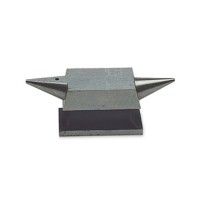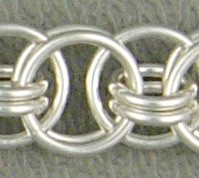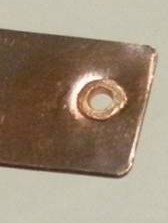- NEW DVD Series – Stone Setting with Bezels
- Tube Set Charm by Kim St. Jean
- Prong Basket Pendant by Kim St. Jean
- NEW DVD Series – Stone Setting with Cold Connections
- New DVD Series – Stone Setting with Wire
- NEW DVD Series: Introduction to Stone Setting by Kim St. Jean
- Featured Tool: Bracelet Bending Plier
- NEW Dvd by Eva Sherman
- Fun, Fast Fold Forming DVD Series
- Double Band Ear Cuff from Alex Simkin
Twisting 101
by Judy Ellis, Wire-Sculpture.com
Tip for March 28, 2014
Wire Twisting 101- Jewelry Making Tools
Twisted wire can add style, dimension, and elegance, flash or fun to a wire jewelry design. Sometimes twisted wire is a major player, placed where it is to be seen and sometimes it is added in obscure places to add interest to a design such as within the sides of a framed cabochon.
I receive questions from those who are a bit confused as to how to twist wire, what to twist and when to use it, so my hope is that this article enables you to have more fun using twisted wires in your jewelry designs.
Let’s begin by looking at a variety of ‘wire twisters’, and how to use them.
1. Wire-twisting pliers:
They are basically a pair of large, heavier pliers with an attached pin vise that has a spring-loaded handle.
How to use it:
- After cutting the desired length of wire to be twisted, one end is tightly secured to a solid surface such as winding it around a nail on a bench or a wall, (or having another person hold the end firmly in a heavy pair of flat-nose pliers).
- The operation is to then insert the other end of the wire(s) through a hole at the back of the plier’s jaws and then into the end of the pin vise.
- After locking the wires tightly into the pin vise, the round knob at the end of the pin vise is pulled out and let go, causing the spring mechanism within the pin vise unit to twist the wire(s). It can be continuously pulled and released until the wire is twisted to satisfaction, and would be best used for lengths of wire18-inches and longer.
- After the desired twist has been achieved, open the pin vise to release the wire and pull it out of the pliers, then unhook the wire from the nail or other secured end. Yes, these pliers can be used to twist either a single or most multiple wire combinations.
2. Automatic Wire Twister:
A cordless power screwdriver is a small, compact unit that can be used to twist either a single or most multiple wire combinations easily. The Automatic wire twister has twice the power of most cordless screwdrivers. This automatic wire twister is approximately 7.5 inches tall, has 4.8 volts of power, and spins at 400rpm. Twist almost any size wire at twice the speed!
The three-prong chuck is included, so you don’t need to order an extra twister head–it’s all here. A complete wire twisting package with no other attachments needed. Weight is 1.5 lbs.
Please note: This tool comes with a re-chargable battery pack and A/C Charge Adapter. To recharge the battery pack, you must plug the adapter into a 120 A/C outlet, which is standard for the US. If your country uses another voltage, you may need an adapter for this tool.
How to use it:
- Place the end(s) of the length of wire(s) to be twisted into the chuck and spin the chuck tightly closed around the wire(s).
- Hold the opposite end of the wire firmly in a pair of flat-nose pliers and push the button in either the forward or the reverse direction and twist until the desired effect has been obtained.
- Open the chuck and release the wire. (Having the option of either forward or reverse is nice when planning wire designs.)
- Most power screwdrivers include an A/C adapter that can be used to charge the unit for use without electricity. The A/C adapter is also a nice feature as when the charged power has run out, the unit can still be used while plugged into an electric source and charging. Yes, a power screwdriver can be used to twist really long lengths of wire, gauges 12 and smaller.
3. Pin Vises: There are two types.
Swivel Head Pin Vise
Double Ended Pin Vise
How to use them:
Each is used in the same manner.
- Twist one of the heads to open the inset jaws and then insert the end of a single piece of wire, (or two or three small gauged wires), into the center and twist the head tightly closed around the wire(s).
- Hold the opposite end(s) of the wire(s) firmly with flat-nose pliers and twist the pin vise with the other hand until the wire is twisted to the desired look.
- Then twist the head open to release the wire.
These units are most often used to twist shorter lengths of wire, from ¼-inch to 12-inches. Each of these two pin vise styles can be used to twist separate segments on the same wire.
Holding Wire While Twisting:
Although a pair of chain-nose pliers can be used, I prefer to use flat-nose pliers to hold the opposite end of the wire. The larger surface area inside the jaws of a flat-nose give more stability and you do not have to hold them in a ‘death grip’, thus preventing possible damage to your hand or wrist.
How to properly twist:
- Place about 1/8-inch of the wire end into the jaws of flat-nose pliers, about mid-way down the jaw.
- Hold the pliers so they are vertical to the horizontal position of the wire, grip firmly and hold the wire so it is just tautly and twist away! If you hear a ‘clicking’ noise coming from the flat-nose end, you are not holding the wire tightly enough and the wire is turning within the flats.
What about wire?
We receive a lot of questions with regards to confusion about the sizes, shapes and tempers of wire to twist or not to twist. Here are a few facts to remember:
• Twisting any temper of wire will harden it!
• The more tightly any wire is twisted, the thinner and weaker the wire becomes; therefore take care when working a tightly twisted wire using complicated techniques.
Twisting Square Wire:
• When an individual square wire is twisted, the resulting appearance is similar to a diamond cut chain, which is referred to as a ‘bead’.
• Although two individually twisted square wires can then be twisted together,due to the difficulty in getting each individually twisted to the same ‘bead’, the result will more than likely be a looser twist as the two twisted wires will seem to repel each other.
Twisting Round Wire:
• A single round wire cannot be twisted to get a ‘party streamer’ or coiled appearance.
• Two or more round wires can be put into a wire twister and twisted together.
• Round wire can be twisted around a square wire.
Twisting Half-round Wire:
• Half-round wire can be twisted around a square or a round wire.
• Half-round wire can be twisted individually.
For more detailed instruction – Check out our complete line of Instructional DVDS to get you started!
I hope this answers a few of the many questions about twisting wire. If you’re a beginner, don’t be afraid to try it.
Happy Twisting!
![]()
Click to Receive Daily Tips by Email




























Karen Motta
March 28, 2014 at 8:03 am
Thanks for the great tips!!! Now I understand why sometimes I have difficulty using my pin vise…………no one ever mentioned to use flat nose pliers. I should have realized this technique was the logical approach. Sometimes the easiest solutions just escape me. ;;)) I totally love your tips as they are very helpful as well as tips from customers. Waiting for an order of wire to arrive. Can’t wait to design some pieces. Your products are fantastic!
Yvonne Ball
March 28, 2014 at 9:08 am
What can I use to get my wire-twisting pliers locked around the wire. I find it beyond my strength to grip it tight enough to lock it. thank you for any tips.